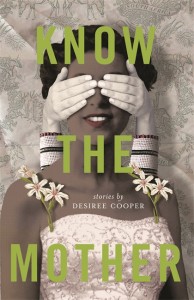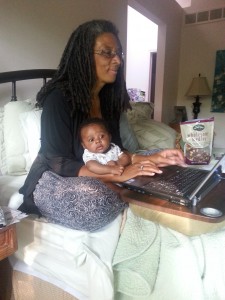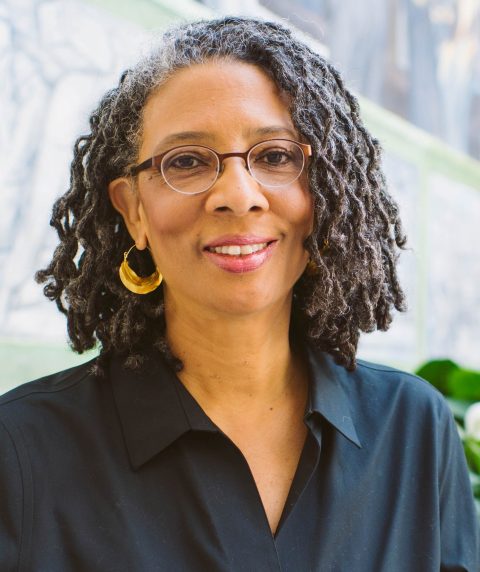Editor’s note: Desiree Cooper will be giving away a copy of her short story collection, Know the Mother, to the author whose story she chooses for publication. Desiree will be reading all stories submitted from August 15-21 2016.
One of my favorite stories in Know the Mother is “To The Bone.” I love how the language around food is sumptuous and lyric compared to some of the other ways you use language in that story. And I’m impressed by how many years you cover in such a short amount of space. Was the story always from the grandmother’s perspective? What made you decide to use food as a vehicle to discuss generational differences in the perception of beauty?
One of the biggest differences between the majority culture in the United States and minority cultures is the relationship to food—especially for women. Not only is food our expression of home, joy, celebration, well-being and culture, it is also tied to notions of beauty. My grandmother used to call everyone “fat,” by which she meant radiant, beautiful and healthy. In the black community, fat babies are a sign of prosperity, pride and luck. It’s no mistake that the word “phat” became slang for beauty, and sexiness in urban communities, hence Baby Phat jeans. But the relationship with the predominant culture contorts that view for communities of color. ”To the Bone” demonstrates how “fatness” went from prosperity to shame in just two generations. The story had to come from the grandmother’s perspective because she’s the one who remembers what it means to be poor and hungry.
 How do you think your work and training as a journalist has influenced you as a flash fiction writer?
How do you think your work and training as a journalist has influenced you as a flash fiction writer?
There is no question that my training as a journalist has profoundly shaped my work as a fiction writer. When, after launching my family and my career, I finally had some time to dedicate to my writing, I discovered that I could not carry a narrative past a few pages. After being a newspaper columnist for more than a decade, compression had become second nature. Thank goodness flash fiction was there for me, or I would have had to invent it.
What was your process like for building Know the Mother?
As a wife, mother, and as someone who also worked outside of the home, I encountered the time and mental energy squeeze that plagues so many women. Over the years, belonging to writing groups has been the only way I kept my creative spirit alive. Know the Mother was built in those groups, especially one I belonged to in Detroit called the Full Moon Sisters. They remain my support and creative midwives.
My writing process is herky jerky. I don’t get up at 5 a.m. and write every day, mostly because the rest of my life keeps me sleeping sporadically and I am not functional without rest. Also, my muse is very particular about not showing up when I’m angry, stressed, depressed or overwhelmed. So now I’m down to three hours a month where the climactic conditions are perfect for writing. And if they don’t coincide with when I’m actually free to write, I’m screwed. All that to say, is that I write when I can, and I never write by hand. I have to thank my journalism training for the fact that I ever get anything down at all.
The stories in Know the Mother have a similar theme—women’s struggle with the mantle of motherhood—because it is the singular struggle of my adult life. Nearly everything I write is connected to the question of how women negotiate the constraints of sexism and racism in intimate settings.
One other thing that impresses me about Know the Mother is how racially inclusive it
is. While reading this it felt like you were working toward a global exploration of femininity, mother and daughterhood, and a perception of what it means to be a woman. What advice would you give writers trying to explore larger concepts such as those in their work?
I’d advise them to create as inclusively as possible with one caveat: write what you know. You can’t appropriate or manufacture someone else’s culture and expect your writing to  be authentic. For example, I was born in Japan and lived there for nine of my formative years. I don’t claim to know everything about Japanese people, language and culture, but I do have my own authentic experience of Japan that informs my writing. That means that if you want to be more inclusive in your writing, then you have to be more inclusive in your life.
be authentic. For example, I was born in Japan and lived there for nine of my formative years. I don’t claim to know everything about Japanese people, language and culture, but I do have my own authentic experience of Japan that informs my writing. That means that if you want to be more inclusive in your writing, then you have to be more inclusive in your life.
As a writer who wishes to engage women and validate their experiences, it’s important to me to be as broad as possible. Because my stories are not linked, I was not limited to how many cultures or characters that I could pull into the collection. That gave me latitude to draw from many backgrounds to tell my stories. Some women are wealthy, some are women of color, some are young, some are immigrant and some are traditional. I think the breadth of the characters speaks to the omnipresence of patriarchy and the persistent problem of how to live with it (or not).
Who are your literary mothers?
The poet Toi Derricotte is my literal literary mother. More than 20 years ago, she invited me on the board of Cave Canem, a national residency for emerging black poets. Being a part of that organization taught me so much about craft, about voice, about courage and about the power of the written word. As a poet, Toi understands the human heart and is not afraid to dig into it.
I’ve always loved Kate Atkinson’s prose. In Life After Life, each scene loops back through itself, with one small change that makes the trajectory of the main character’s life bounce in different ways. What if she’d been stillborn? What if she survived? What if she lived in London? What if she lived in the country? What if she married and had children? What if she’d remained single? It’s a broken narrative and a work of art.
Edwidge Danticat is magic. Her books are about women’s lives and the burden that sexual and social politics puts upon their relationships as wives, mothers and daughters. She writes from inside Haitian culture, but we see ourselves in their stories. She is an amazing visual artist with words.
I have to mention Nobel Laureate Pearl Buck, who gave Western readers a glimpse into feudal Chinese life. People are familiar with The Good Earth, but Pavilion of Women is also a favorite. It tells the story of a 40-year-old woman who decides that she is no longer serving her husband or her sons. She finds a concubine for her husband and moves to quiet quarters on their compound to read, study and explore in peace. That’s subversive for feudal China, and just as subversive for an American woman writing in 1946!


 The core workshop of SmokeLong Fitness is all in writing, so you can take part from anywhere at anytime. We are excited about creating a supportive, consistent and structured environment for flash writers to work on their craft in a community. We are thrilled and proud to say that our workshop participants have won, placed, or been listed in every major flash competition. Community works.
The core workshop of SmokeLong Fitness is all in writing, so you can take part from anywhere at anytime. We are excited about creating a supportive, consistent and structured environment for flash writers to work on their craft in a community. We are thrilled and proud to say that our workshop participants have won, placed, or been listed in every major flash competition. Community works.